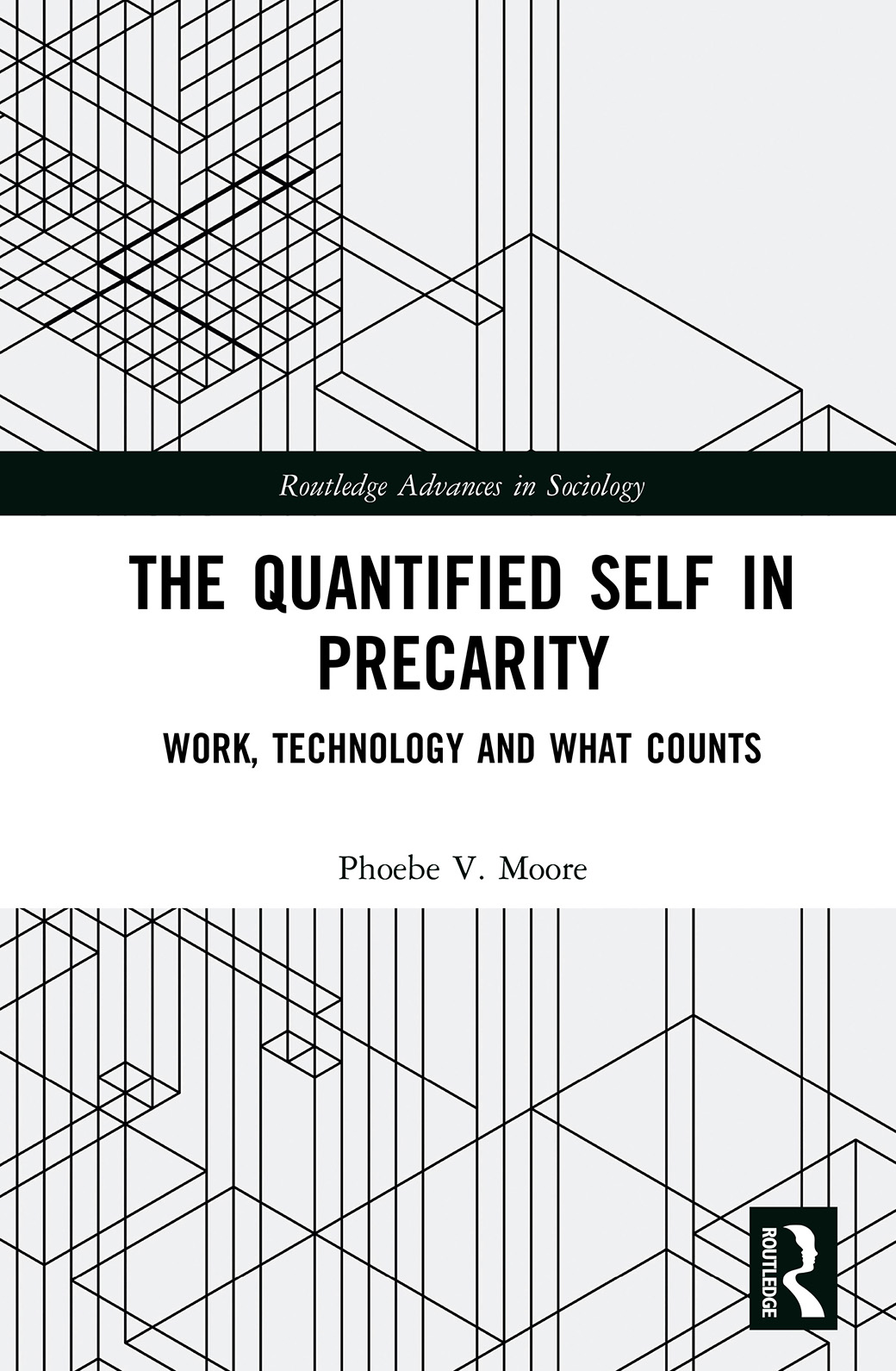Contents
The Quantified Self in Precarity
Work, Technology and What Counts
Phoebe V. Moore

First published 2018
by Routledge
2 Park Square, Milton Park, Abingdon, Oxon OX14 4RN
and by Routledge
711 Third Avenue, New York, NY 10017
Routledge is an imprint of the Taylor & Francis Group, an informa business
2018 Phoebe V. Moore
The right of Phoebe V. Moore to be identified as author of this work has been asserted by her in accordance with sections 77 and 78 of the Copyright, Designs and Patents Act 1988.
All rights reserved. No part of this book may be reprinted or reproduced or utilised in any form or by any electronic, mechanical, or other means, now known or hereafter invented, including photocopying and recording, or in any information storage or retrieval system, without permission in writing from the publishers.
Trademark notice: Product or corporate names may be trademarks or registered trademarks, and are used only for identification and explanation without intent to infringe.
British Library Cataloguing-in-Publication Data
A catalogue record for this book is available from the British Library
Library of Congress Cataloging-in-Publication Data
A catalog record for this book has been requested.
ISBN: 978-1-138-67406-6 (hbk)
ISBN: 978-1-315-56152-3 (ebk)
Typeset in Sabon
by codeMantra
The Quantified Self in Precarity: Work, Technology and What Counts is dedicated to my families the Carters, Moores, and van Somerens; my dearest Aureol; my partner Dan whose support has been immeasurable; my wonderful friends Christine and Joan who have inspired me since childhood; my more recent friends Ben, Felicity and Michael whose solidarity is unequalled; and Tokyo Rose, my cat whose animal affective labour is an ongoing lifesaver.
This is a compelling, timely and a much-needed analysis of the ways in which technological developments are increasingly affecting the sphere of labour and employment relationships. It covers a variety of pertinent and topical issues including automation, precarity, quantification, and surveillance at the workplace, thereby advancing the current debates on these issues. I highly recommend this book to anyone seeking to understand the intricate interplay between technology, power and agency in the context of work.
Btihaj Ajana, Kings College London and Aarhus University
This original admixture of critical analysis and passionately written warnings against the dark sides of algorithmic rule raises fundamental questions about human involvement with machines. Exploring the variety of ways to quantify work and workers, Moore offers a rich account of the oppressive effects of calculative practices and politically promising ways to counter them.
Minna Ruckenstein, University of Helsinki, Finland
Moores book offers a timely overview of the critical models of the working body as a labour value. What counts, in Moores astute narrative, is how the fleshed capital potential of this value is measured and turned into data. The Quantified Self, as Moore argues, may be used as units for the service of post-industrial processes, yet this values very identification has also enabled sites of resistance, generative of affirmative moments of change.
Felicity Colman, Kingston University, London
The Quantified Self in Precarity
Humans are accustomed to being tool bearers, but what happens when machines become tool bearers, calculating human labour via the use of big data and people analytics by metrics?
The Quantified Self in Precarity highlights how, whether it be in insecure gig work or office work, such digitalisation is not an inevitable processnor is it one that necessarily improves working conditions. Indeed, through unique research and empirical data, Moore demonstrates how workplace quantification leads to high turnover rates, workplace rationalisation and worker stress and anxiety, with these issues linked to increased rates of subjective and objective precarity.
Scientific management asked us to be efficient. Now, we are asked to be agile. But what does this mean for the everyday lives we lead?
With a fresh perspective on how technology and the use of technology for management and self-management changes the quantified, precarious workplace today, The Quantified Self in Precarity will appeal to undergraduate and postgraduate students interested in fields such as Science and Technology, Organisation Management, Sociology and Politics.
Phoebe V. Moore is an active researcher and a Senior Lecturer in International Relations at Middlesex University, UK.
Routledge Advances in Sociology
For a full list of titles in this series, please visit www.routledge.com/series/SE0511
226 Open Borders, Unlocked Cultures
Romanian Roma Migrants in Western Europe
Edited by Yaron Matras and Daniele Viktor Leggio
227 Digital Music Distribution
The Sociology of Online Music Streams
Hendrik Storstein Spilker
228 Liberalism 2.0 and the Rise of China
Global Crisis and Innovation
David Tyfield
229 The Quantified Self in Precarity
Work, Technology and What Counts
Phoebe V. Moore
230 Theorizing Digital Divides
Massimo Ragnedda and Glenn W. Muschert
231 Child Figures, Literature, and Science
Fragile Subjects
Edited by Jutta Ahlbeck, Pivi Lappalainen, Kati Launis and Kirsi Tuohela
232 Mass Shootings in Comparative Perspective
Communities and Shared Experiences in the Aftermath
Johanna Nurmi
233 Mega-Events as Economies of the Imagination
Creating Atmospheres for Rio 2016 and Tokyo 2020
Rodanthi Tzanelli
Contents
Diarising, quantification of activities and self-experimentation are not unprecedented obsessions. King Charles II had a penchant for weighing himself at specific times in the day. A report from the Royal Societys archives from 9 March 1664 written by Sir Robert Moray indicates that Charles II, aged 34 at the time of this report,
had the Curiosity of weighing himself, very frequently, to observe the severall Emanations of his Body, before and after sleep, Tennis, Riding abroad, Dinners and Suppers: and that he had found he weighed lesse after Tennis, by two pounds three ounces (but the King drinking two draughts of Liquor after play, made up his weight;) after Dinner, by four pounds and an halfe.
(Corden, 2013)
Sanctorious of Padua, noted for introducing quantitative approaches to medicine in the 16th and early 17th century, weighed himself before and after meals, weighed his meals and then weighed his excrement (Neuringer, 1981: 79). Dali is also said to have meticulously measured his excrement.
While the King, the physician and the artist tracked physical expressions, other historical figures measured the less tangible. Benjamin Franklin kept his moral compass in track quite explicitly through daily self-examination and keeping track of his actions in a little book which contained a page for each of the virtues, one of which was temperance, where the subheading stated eat not to dullness: drink not to elevation. A grid beneath listed the various types of violations one might commit in relation to the virtue along a timeline of days. Franklin would make a little black spot for every fault I found upon examination to have been committed respecting that virtue upon that day. Buckminster Fuller was an avid self-tracker and gave himself the nickname guinea pig b; he kept a scrapbook diary about his day-to-day life and his ideas.












